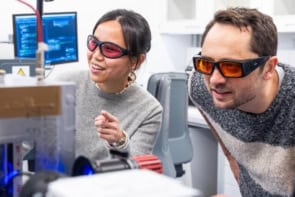Ever wondered how nanoparticles grow? Then you're in luck, because a team of French researchers has developed a system that can monitor the development of nanoparticles in real time. The scientists, from the Commissariat à l'Energie Atomique Grenoble, the University of Paris, CNRS Research Centre for Crystal Growth Mechanisms, Université Louis Pasteur and Laboratoire Louis Néel, examined the growth of palladium islands on a magnesium oxide surface and cobalt nanodots on gold (G Renaud et al. 2003 Science 300 1416).
“Nanoparticles are very important for the future of nanotechnology and their new properties (either semiconducting, photonic, magnetic or catalytic) depend strongly on their shape, size and ordering,” said Gilles Renaud of the Commissariat à l’Energie Atomique Grenoble. “These characteristics are in turn defined by the growth conditions.”
To carry out the technique, the researchers used grazing-incidence small-angle X-ray scattering (GISAXS). Examining the scattering of the X-ray beam from a surface on which nanoparticles are forming provides valuable information about their properties, such as particle height, particle lateral size, morphology and average island separation. According to Renaud, the tool can characterize the shape and ordering of nanoparticles in situ in a fully quantitative way.
The scientists developed their apparatus at the European Synchrotron Radiation Facility. They coupled an ultrahigh-vacuum chamber directly with the synchrotron ring, a feature that enabled them to avoid scattering elements along the pathway of the X-ray beam. The team was able to record scattering patterns in a few tenths or hundredths of a second, allowing them to show the nanoparticle growth as a movie in real time.
“Potential applications would be for people involved in the elaboration of assemblies of nanoparticles for the micro-electronic or catalysis industries,” added Renaud. “They could develop similar experimental setups that would allow them to characterize the morphology of their systems precisely while they are grown, whatever the environment.” Now the team is trying to find new systems that undergo self-organized growth, and to apply the technique under catalytic conditions. “Our technique is very sensitive to the organization of the particles, and hence will be useful in tuning the growth parameters to achieve self-organized growth,” explained Renaud.



